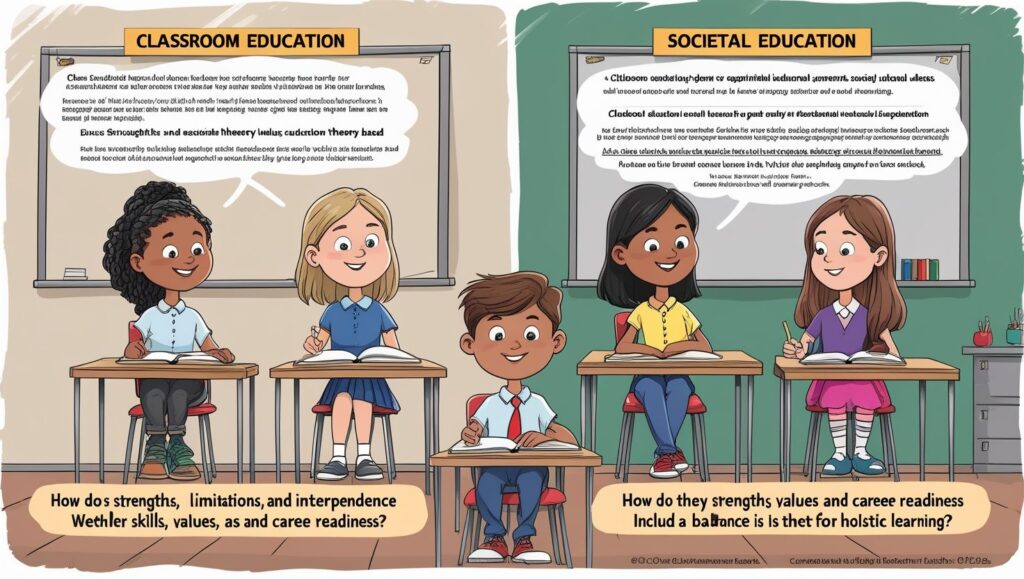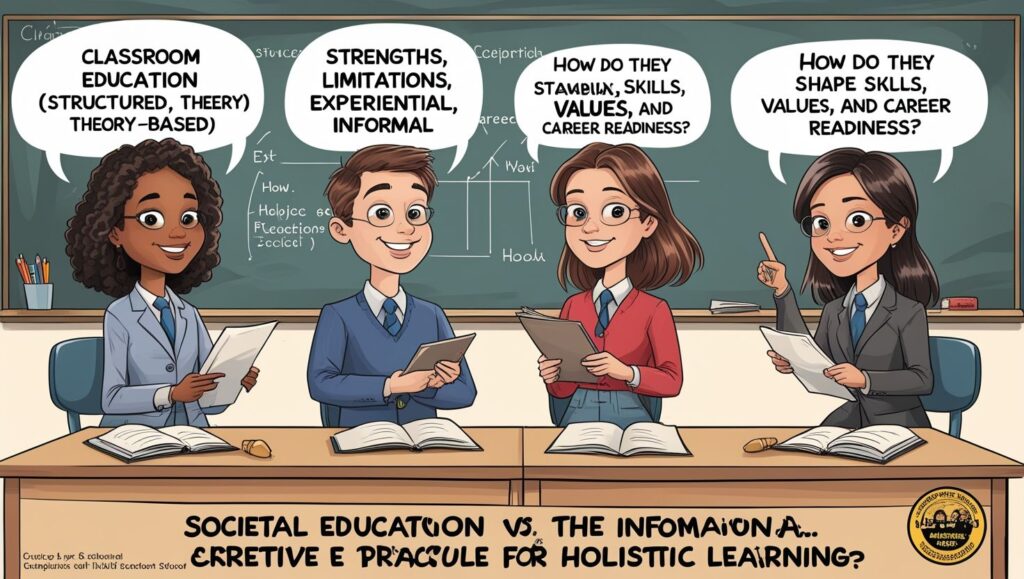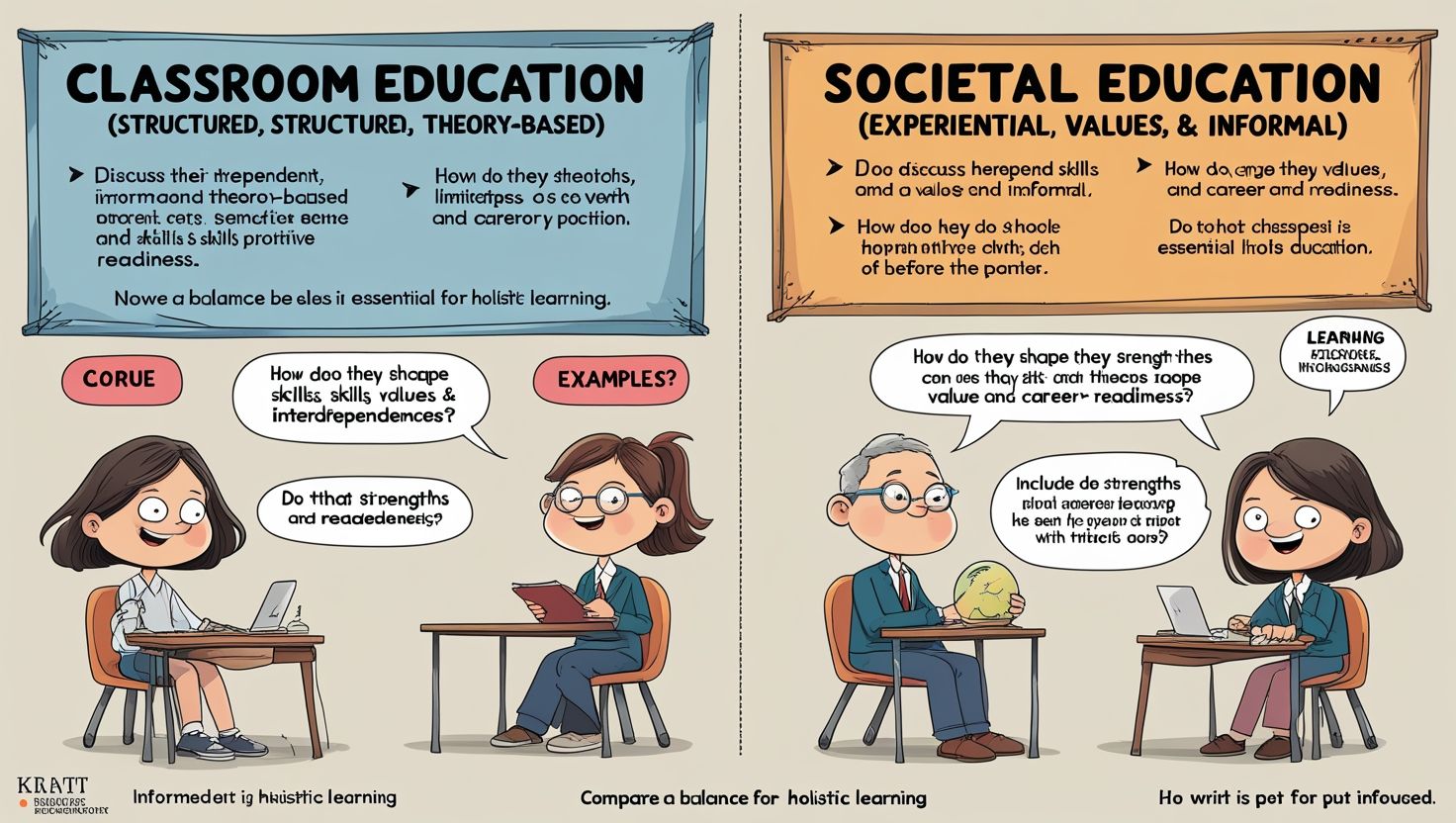Introduction
Classroom vs. Society Education, Education is a lifelong process that occurs in both formal and informal settings. While classroom education provides structured learning within schools and universities, societal education encompasses the knowledge, values, and skills acquired through real-world experiences, cultural interactions, and community engagement. Both forms of education play crucial roles in shaping individuals, but they differ in their approaches, objectives, and outcomes.
Classroom education follows a standardized curriculum, focusing on academic knowledge, critical thinking, and professional development. In contrast, societal education is unstructured, emphasizing adaptability, social skills, and practical wisdom gained from daily life. The debate between these two forms of education raises important questions: Which is more valuable? Can they coexist harmoniously? How do they contribute to personal and professional growth?
This article explores the differences and intersections between classroom and societal education, examining their advantages, limitations, and real-world applications. By understanding both systems, we can appreciate how they complement each other in fostering well-rounded individuals capable of navigating modern challenges.
Background of Classroom and Societal Education
Classroom education has been the cornerstone of formal learning for centuries, evolving from ancient institutions like Plato’s Academy to modern-day schools and universities. It is designed to impart theoretical knowledge, scientific principles, and technical skills through a systematic approach. Governments and educational boards regulate curricula to ensure consistency and quality, preparing students for careers and higher education.
On the other hand, societal education is as old as human civilization itself. It includes learning from family, peers, work environments, and cultural traditions. Apprenticeships, mentorships, and community interactions fall under this category. Unlike classroom education, societal learning is experiential, often teaching resilience, emotional intelligence, and problem-solving in unpredictable situations.
Historically, societies relied on oral traditions and hands-on training before formal schooling became widespread. Today, while classroom education dominates, societal education remains indispensable in developing practical life skills that textbooks cannot fully provide.

Main Ideas: Comparing Classroom and Societal Education
1. Structured vs. Unstructured Learning
Classroom education offers a controlled environment with clear objectives, syllabi, and assessments. Students follow a predetermined path, ensuring foundational knowledge in subjects like mathematics, science, and literature. However, this rigidity can limit creativity and real-world applicability.
Societal education, in contrast, is flexible and adaptive. Learning occurs naturally through experiences—such as managing finances, resolving conflicts, or networking. This form of education is more dynamic but lacks formal certification, making it harder to quantify.
2. Skill Development
Classrooms emphasize cognitive skills—analysis, memorization, and theoretical understanding. Standardized tests measure academic performance, which is crucial for career qualifications.
Society, however, teaches soft skills—communication, leadership, and emotional intelligence. For instance, a part-time job teaches time management, while volunteering builds empathy. These skills are essential for personal and professional success but are rarely graded in schools.
3. Socialization and Cultural Awareness
While schools provide peer interactions, societal education exposes individuals to diverse cultures, traditions, and perspectives. Travel, community service, and multicultural environments foster tolerance and global awareness—qualities increasingly important in a connected world.

Examples of Classroom and Societal Education in Practice
- Classroom Education: A student learns economic theories in school but understands real-world budgeting only through managing personal expenses.
- Societal Education: An entrepreneur may lack a business degree but succeeds through hands-on experience, customer interactions, and market adaptability.
- Combined Approach: Medical students gain theoretical knowledge in classrooms but refine diagnostic skills through hospital internships, blending both learning forms.
References
- Dewey, J. (1938). Experience and Education. Simon & Schuster.
- Illich, I. (1971). Deschooling Society. Harper & Row.
- UNESCO. (2021). The Futures of Education: Learning to Become.
Conclusion
Both classroom and societal education are vital, each compensating for the other’s limitations. While formal education provides credentials and foundational knowledge, societal learning cultivates adaptability and practical wisdom. An ideal education system should integrate both, ensuring students are not only knowledgeable but also resilient, socially aware, and capable of real-world problem-solving.
Frequently Asked Questions (FAQs)
- Can societal education replace formal schooling?
No—both are complementary; formal education provides credentials, while societal learning offers practical skills. - Which is more important for career success?
Depends on the field; professions like medicine require formal training, whereas creative industries may value experience more. - How can schools incorporate societal education?
Through internships, community projects, and experiential learning programs. - Does societal education have disadvantages?
Yes—it can perpetuate biases or misinformation without structured guidance. - Can self-learning replace both?
Self-directed learning (e.g., online courses) bridges the gap but lacks socialization aspects.

Thanks for sharing! I learned something new today.
Üvezli su kaçak tespiti Mutfaktaki su sızıntısının kaynağını akustik cihazlarla buldular. Dolaplara zarar vermeden tamir ettiler. Yılmaz S. https://www.weddcation.com/2012/10/
6wemfs
9rfzxv